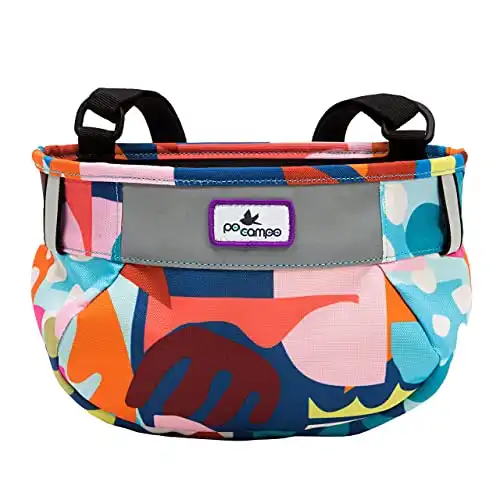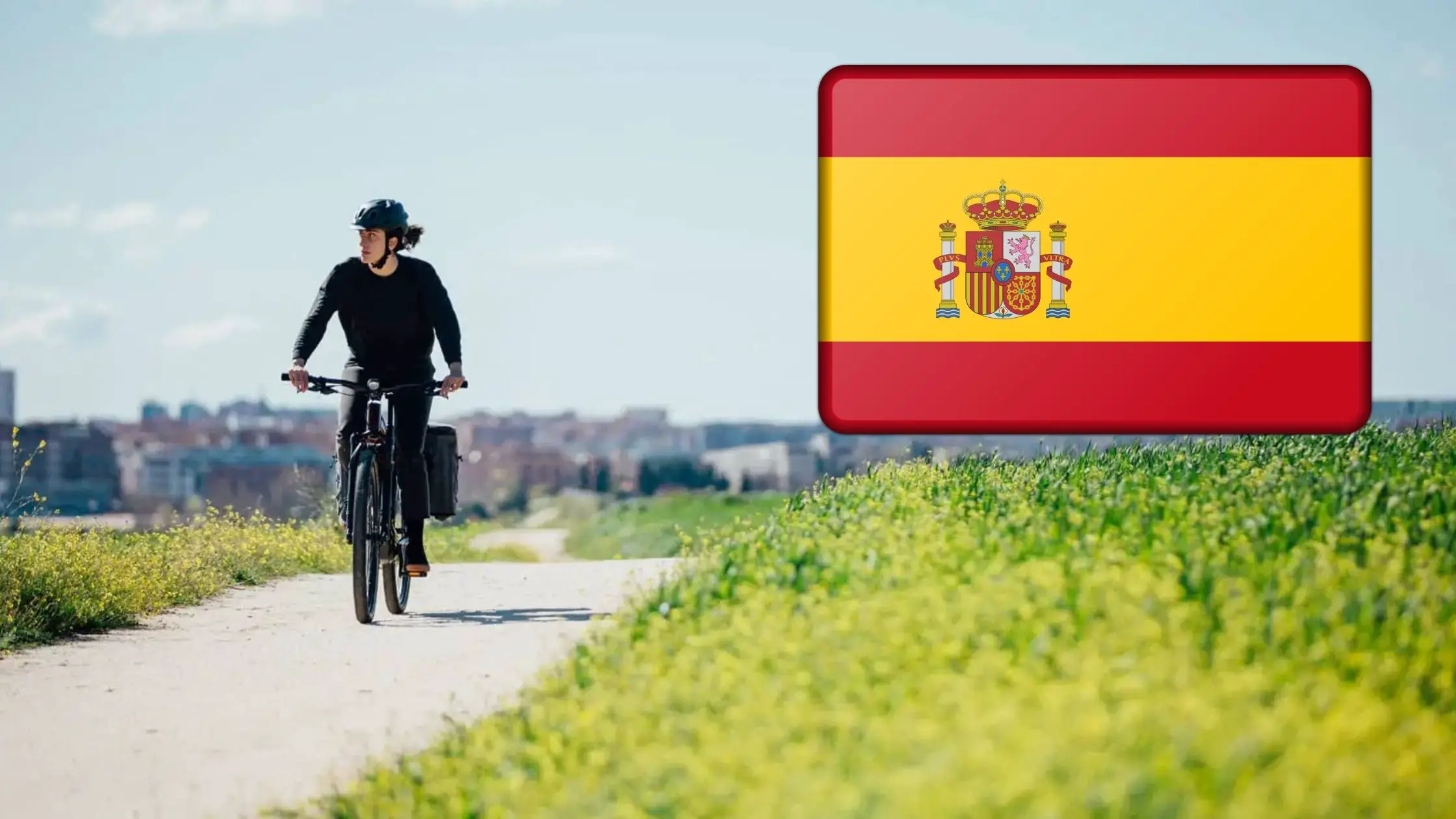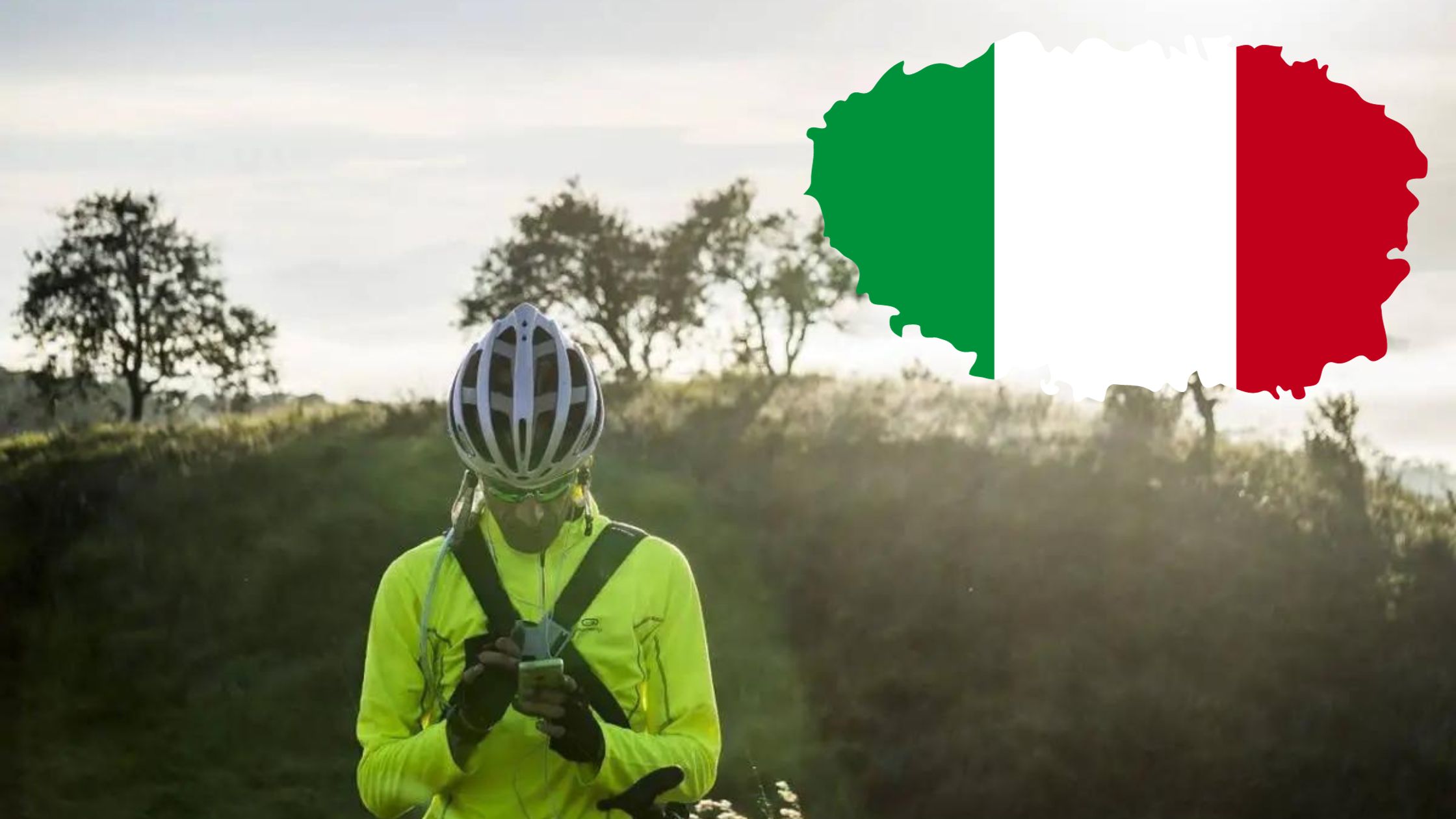Last Updated on June 1, 2023 by Igor Karni

The truth is that electric bicycles are perfectly suitable for bikepacking! You don’t need to be a professional cyclist, but preparation does require a bit more planning to help avoid unpleasant surprises.
Table of Contents
Unsurprisingly, the biggest concern with using e-bikes for traveling is recharging. More and more solutions become available to recharge your electric bike and cover long distances.
What bikepacking equipment to choose? What e-bike to prefer for bike travel? Bags, routes, charging areas, battery life… we explain how to organize a proper electric bike trip.
What is bikepacking?
Bikepacking is the cycling version of backpacking without taking unnecessary belongings with you. The objective is to pack everything on your e-bike using bags on the frame and a luggage rack.
The idea is to reduce weight as much as possible and distribute it evenly on the e-bike to move faster and more easily. It is a minimalist approach that represents freedom and adventure.
Which type of e-bike is best for bikepacking?
It depends on your itinerary and the routes you will take.
While a regular e-bike is suitable for short trips or on paved roads, it is better to invest in an electric touring bike, a hybrid e-bike, a full-suspension electric mountain bike, or an electric gravel bike if you plan on exploring unpaved roads, rugged terrain, or routes with significant elevation changes.
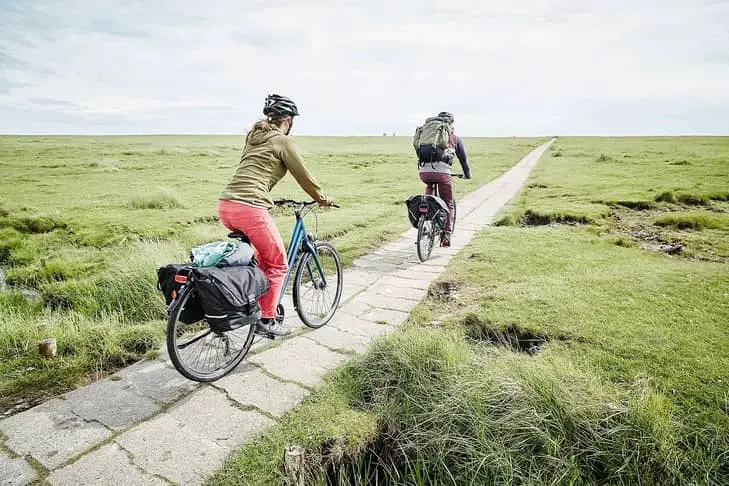
You should consider the weight of the e-bike when choosing between a heavy-duty motorized bike that will accompany you from A to Z or a lightweight motorized bike that will require more effort but will still be rideable even after the battery runs out.
Here are some electric bike models that are perfect for traveling and exploring:
- The ultra-versatile Samedi 27 Xroad by Moustache Bikes
- The electric gravel bike Turbo Creo SL EVO by Specialized
- The electric mountain bike Turbo Tero by Specialized
- The electric hybrid bike Endeavour 5.B Advance by Kalkhoff
- The electric touring bike Entice 1.B Move by Kalkhoff
- The flat-bar gravel bike Dimanche 29.2 Gravel by Moustache Bikes
Read also: Why fat tires are good news for electric bikes? And, How to select the best hybrid e-bike?
What battery autonomy is needed for bikepacking on an e-bike?
Beyond comfort and geometry, battery autonomy is extremely important, as you might imagine. For e-bike travel and long-distance rides, choose an electric bike with a battery capacity of at least 500 Wh.
This is not an absolute value: it also depends on the weight of the e-bike. Some road or gravel e-bikes weigh much less than an electric touring bike. For them, a battery of around 300 Wh is sufficient. For example, the Turbo Creo SL gravel bike has a 320 Wh battery.
Don’t forget that you will be adding weight to the bike with your luggage, which means it consumes more battery.
Read also: What is the difference between e-bike batteries? And, How far can e-bikes go? What is the e-bike range?
What distance can be traveled on an electric bike?
Bikepacking is a leisure activity, so you don’t necessarily have to rush.
Moreover, if you take the road, a bike traveling at 25 km/h doesn’t need much motor energy: you can rely on the eco modes of your e-bike and consider that you will reach the higher distance value on the scale provided by the manufacturer.
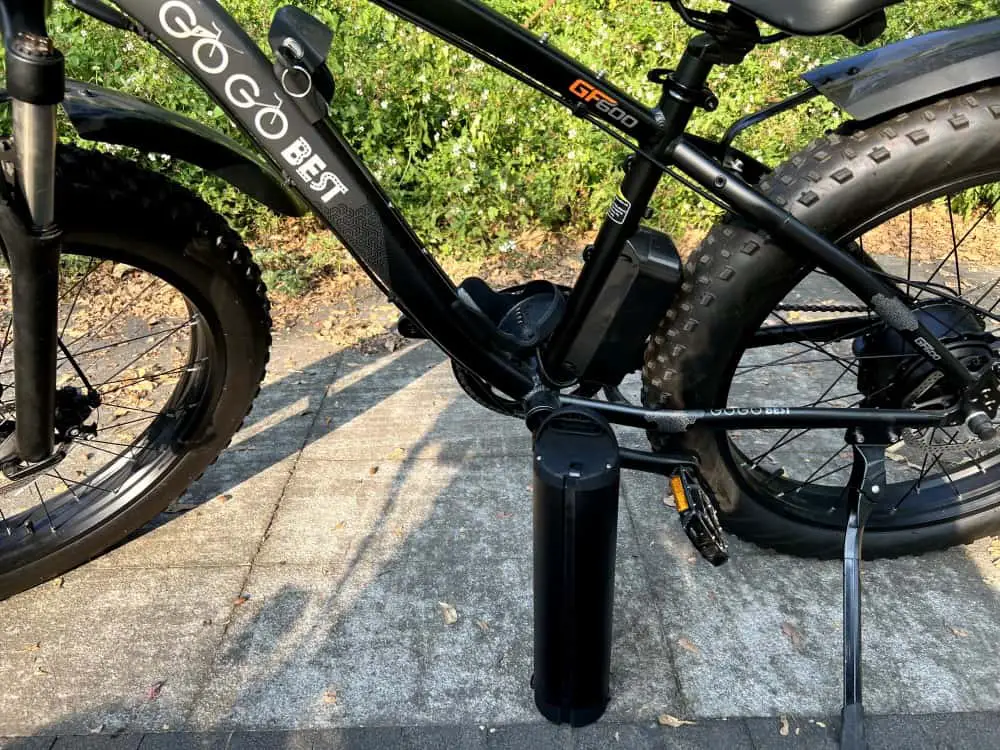
If you opt for a hybrid bike like Canyon’s Endurace:ON, you will have to exert more effort, but you will be able to go much further, even continuing without a problem when the battery is flat. Battery autonomy will be less of a criterion to consider: you can rely on your legs to reach your next stop.
What bags should to choose for bikepacking?
A handlebar bikepacking bag
Use it to store your essentials and small, low-volume items (identity papers, money, a repair kit, a small snack, a rain jacket skillfully folded to deal with the weather, a camera, etc.).
A frame bikepacking bag
These bags can take up all the space or simply attach to the top tube. Ensure they are compatible with your e-bike: sometimes, with the battery on the frame, such bags may not fit!
A saddle bikepacking bag
This one attaches to the seat post, usually via straps. Such bags are designed for adventure cycling and bikepacking. They don’t interfere with the bike’s steering. These bags usually come equipped with an air venting system.
Bags on the rear rack
Side bags are more suitable for less sporty riding; they are therefore highly appreciated for bike travel. They offer large storage space, so they should be preferred for long-distance bike trips and self-sufficient stays (camping and tents).
One recommendation applies to all bags: choose waterproof models so that bad weather is not a concern. The list of bags is not exhaustive: there are also models that attach to the fork, for example.
Luggage capacity: what volume do you need for bikepacking?
It all depends on:
- the length of your e-bike trip,
- the degree of autonomy (full camping in nature, accommodation in a guesthouse or hotel),
- the time of year you plan your trip (of course, winter cycling clothes take up more space!).
A handlebar bag and a saddle bag, such as, for example, the Apidura Expedition Saddle Pack 17L, are enough for a two-day trip. Beyond that, add a frame bag for a complete bikepacking setup.
Decathlon, Vaude, Ortlieb… Which brands to choose for your bike bags?
Vaude, Ortlieb, and Apidura are the three brands you’ll see most often on a bikepacking setup. They have proven to be weather-resistant and offer durable, functional, and long-lasting products.
Decathlon also offers a range of bags at a good price-quality ratio. Other brands include Blackburn, BBB, and Zéfal. All offer a very good price-quality ratio!
How to distribute your bags on your e-bike for bikepacking?
The goal is to balance the load so that you and your e-bike don’t become unbalanced.
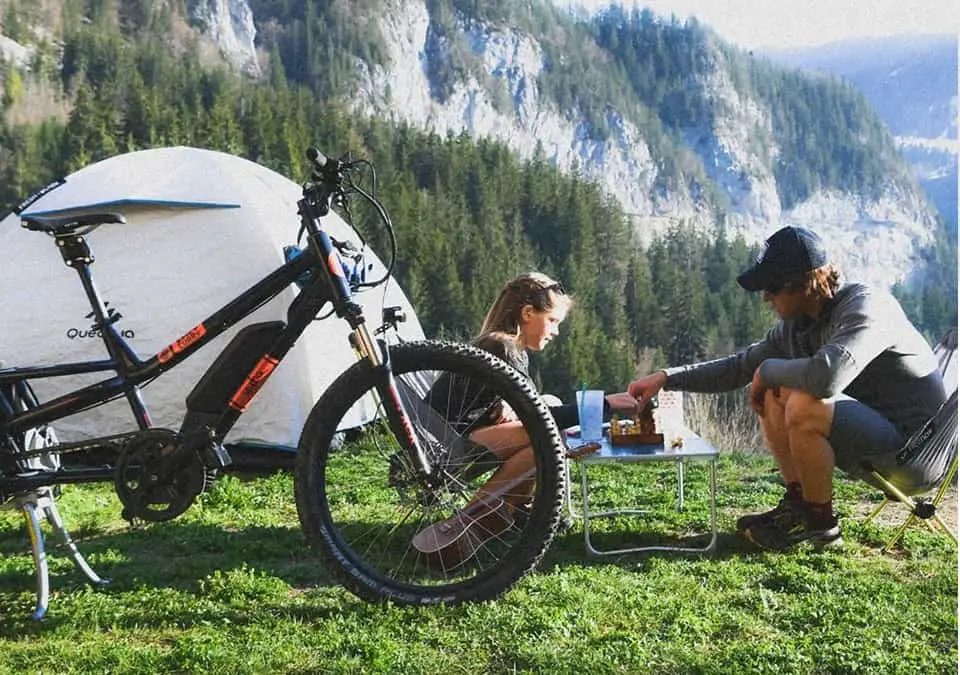
Put everything heavy in the frame bag to lighten the load on the saddlebag. If it’s too heavy, it can alter your center of gravity and hinder you when turning. Don’t load too much on the front, either.
If you ride with two bags on the rack, distribute the load. It’s better to have more bags than to overload 1 or 2. You can put your clothes, sleeping bag, and shoes in the back.
Use Voile Straps or Fast Straps from Restrap to save space in the saddlebag. It’s always practical. Protect your shoes from the rain in a plastic bag.
Read also: How much can an e-bike carry? And, Can an e-bike pull a trailer?
What clothes to take for bikepacking on an e-bike?
- Breathable and quick-drying technical clothing
- A rain jacket
- Long or short cycling shorts
- A helmet
- A spare outfit for the city
- Bike shoes with or without cleats
- Lightweight and flexible sneakers or sandals (they fit more easily in the bags!)
For shoes, if you’re not familiar with clipless pedals, you can also buy flat-pedal mountain bike shoes. They have a durable sole and a stiff sole for comfortable pedaling. Don’t plan on hiking in them, though!
Read also: What to take with you an an e-biking trip? And, Can an e-bike pull a trailer?
The list of essential equipment for bikepacking on an e-bike:
- A repair kit (inner tube, patches, tire levers, bike pump)
- The battery charger and its power cable
- A security lock
- Camping equipment: sleeping bag, bivy, tent, etc.
- A chain tool or quick-release pliers.
Where to recharge your electric bike on the trip?
A bike trip on an electric bike requires a minimum of preparation. Before you leave, you need to locate the places where you will be able to recharge your bike.
While you can sometimes rely on the generosity of some restaurants, campgrounds, hotels, and bike shops, you can also recharge your e-bike at charging stations provided by municipalities or regions.
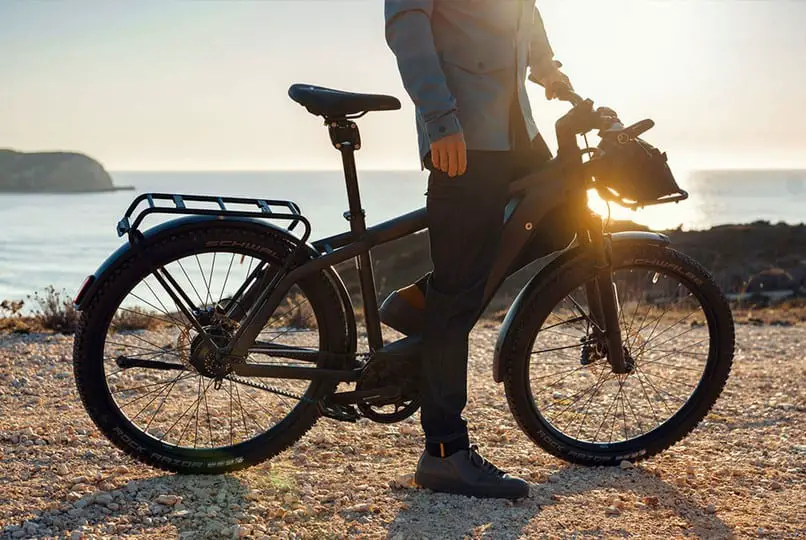
In 2018, Bosch started deploying recharge stations (PowerStations) across Europe. These stations are secure: you access a locker with a key. Bosch stations are now mainly installed in tourist offices and tourist information centers. You can leave your battery charging during lunch break, for example.
Please note that these charging stations are only compatible with Bosch batteries. On related websites, you will find the addresses and phone numbers of tourist offices. It is best to call them beforehand to make sure the charging stations are still working.
Some popular tourist routes for bikepackers and cyclists have also set up charging stations. This is the case of La Loire à Vélo in France, for example, which provides a list of places to recharge your e-bike on its website.
Also, France Vélo Tourisme has implemented the “Accueil Vélo” label, which makes it easy to find bike-friendly accommodation with facilities dedicated to cyclists. They are ideally located near major cycling routes.
Although bikepacking on an e-bike is becoming more and more popular, charging stations are still relatively rare. So it’s best to plan ahead!
Recharge your e-bike faster with a fast charger
Several major manufacturers offer fast chargers to save time. The Bosch Fast Charger 6A allows you to charge your battery up to 50% in about an hour. It takes about 3 hours – a long nap – to fully charge your battery (PowerTube 500 and PowerPack 500 models). The fast charger device weighs 1 kilogram.
For those who have time and prioritize lightness, Bosch also offers the Compact Charger. Smaller than the standard charger, it weighs only 600 grams. However, it takes 7.5 hours to recharge the PowerTube 500 and PowerPack 500 batteries.
Make sure that the fast charger is compatible with your battery model.

Final tips for a smooth e-bikepacking trip
- Depending on your route and charging points, adjust your riding and reduce assistance when possible. Don’t hesitate to shift gears uphill to reduce assistance.
- Use Bosch’s range calculator to plan your routes.
- Inflate your tires to the proper pressure.
- Also, adjust your itinerary: 30 km with 500 meters of positive elevation gain is not the same as 75 km on flat roads.
- Have your e-bike serviced by a bike shop before you leave.
Pro tip
Try testing with a backpack and check its capacity in liters. This will allow you to adjust the number of panniers and their capacity based on your actual needs.
Preparing for your trip
Before you leave, take a test ride with your panniers filled as you would on the actual trip. This will help you get familiar with your loaded e-bike and better distribute the load according to your riding style.
A hot shower?
If you feel like making new connections, you can also sign up for Warmshowers. The community brings together nearly 125,000 hosts where you can spend the night and recharge your bike. A lifetime membership costs $30.
Good to know
On some motors, you can adjust your assistance levels. This allows you to reduce the level of assistance to save battery life.
Read also: Check out world’s best travel destinations by electric bike.
Igor is a sustainable mobility and green energy advocate. His mission for Easy E-biking is to help make electric cycling simple, practical, and fun. Follow him on Facebook and LinkedIn.

